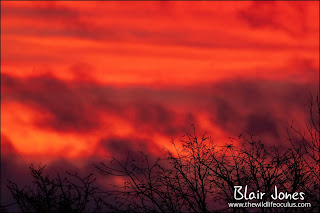Red sky in the morning shepherds warning
 |
| Red sky in the morning |
As I got out of my car at Slimbridge I was greeted by a cacophony of hundreds of crows cawing and the dawn sky was dark and broody except a band of cloud that was backlit red by the rising sun behind them. It was both cool to look at and a little ominous at the same time. You know how the old rhyme goes, "Red Sky at night shepherds delights, Red Sky in the morning shepherds warning"
If I was going to predict the weather based on this then I would have not been far from the truth.
This was the last of the sunshine that I would see all day. The clouds just got thicker, the wind whipped up and the rain came.
Despite this there was plenty to see on this visit.
 |
| White-Fronted Geese make an exit |
First thing there was approximately 100 White Fronted Geese roosting on the Tack Piece. Just as I was about to train my scope on them they all took off and flew to the rear field out of sight.
 |
| Redshanks and Ruff |
 |
| Cattle Egret |
They usually turn up in fields where there are cows grazing. There have been sightings of them closer to home in Monmouthshire but I always seem to miss them for some reason. Not today. Lifer number three of the year. My next target however concerning this species is to see one at Goldcliff :)
 |
| Knots |
Other feathered residents on the South Lake were flocks of Lapwings, Black Tailed Godwits, Dunlin, Avocets, Snipe, and Knots. There was a single Oystercatcher that appears to have been hanging around the last couple of days.
 |
| Lapwing |
The Zeiss Hide was quiet. A huge flock of Golden Plovers could be seen on the fields near the Kingfisher hide. I would estimate that there was probably about 2000 of them. When I got to the Kingfisher hide the fields opposite were full of thousands of Lapwing, a big flock of 500 or more Dunlins and a band of gold that was the plovers. I did not have a wide enough lens to show the sense of scale of it all.
 |
| Golden Plover, Lapwing and Dunlin |
As ever it did not take a great deal to cause the flock to explode into the sky. It was suspected that a Buzzard was causing the birds to fret but I never saw one.
| Golden Plover |
It was good to see a nice flock of Dunlins. I am hoping these fabulous little waders will start gracing my local reserve as the spring migration approaches.
 |
| Big flock of Dunlin |
 |
| Everything up in the air |
My visit finished off with a look at the two North American river otters. Today they were out of the water and looked like they were spreading musk everywhere as they were spending some time rubbing themselves on some logs in the enclosure.
 |
| American river otter |


Comments
Post a Comment